

Space weather. Space weather has two focal points: scientific research and applications.
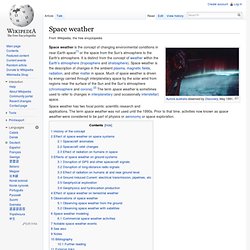
The term space weather was not used until the 1990s. Prior to that time, activities now known as space weather were considered to be part of physics or aeronomy or space exploration. History of the concept[edit] In the 20th century, the interest in space weather has expanded as military and commercial systems have come to depend on systems affected by space weather. Communications satellites are a vital part of global commerce. The International Geophysical Year (IGY), created an enormous increase in research into space weather. Effect of space weather on space systems[edit] Spacecraft anomalies[edit] GOES-11 and GOES-12 monitored space weather conditions during the October 2003 solar activity.[15] Spacecraft malfunction for a variety of reasons. Spacecraft orbit changes[edit]
Cryosphere. This high resolution image, designed for the Fifth Assessment Report of the IPCC, shows the extent of the regions affected by components of the cryosphere around the world.
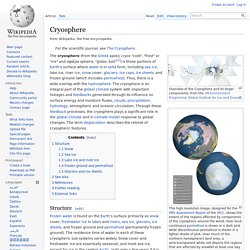
Over land, continuous permafrost is shown in a dark pink while discontinuous permafrost is shown in a lighter shade of pink. Over much of the northern hemisphere's land area, a semi-transparent white veil depicts the regions that are affected by snowfall at least one day during the period 2000-2012. The bright green line along the southern border of this region shows the maximum snow extent while a black line across the North America, Europe and Asia shows the 50% snow extent line.
Glaciers are shown as small golden dots in mountainous areas and in the far northern and southern latitudes. Over the water, ice shelves are shown around Antarctica along with sea ice surrounding the ice shelves. Atmosphere. Composition of Earth's atmosphere by volume.
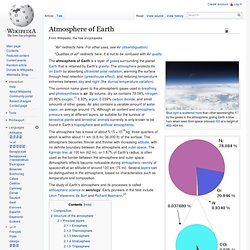
The lower pie represents the trace gases which together compose 0.038% of the atmosphere. The numbers are from a variety of years (mainly 1987, with CO2 and methane from 2009) and do not represent any single source. The common name given to the atmospheric gases used in breathing and photosynthesis is air. By volume, dry air contains 78.09% nitrogen, 20.95% oxygen,[1] 0.93% argon, 0.039% carbon dioxide, and small amounts of other gases. Air also contains a variable amount of water vapor, on average around 1%. The atmosphere has a mass of about 5.15×1018 kg, three quarters of which is within about 11 km (6.8 mi; 36,000 ft) of the surface. The study of Earth's atmosphere and its processes is called atmospheric science or aerology. Composition Mean atmospheric water vapor. Pedosphere. The pedosphere (from Greek πέδον pedon "soil" or "earth" and σφαίρα sfaíra "sphere") is the outermost layer of the Earth that is composed of soil and subject to soil formation processes.
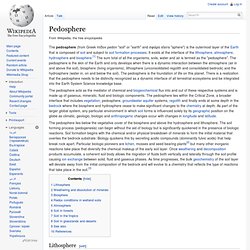
It exists at the interface of the lithosphere, atmosphere, hydrosphere and biosphere.[1] The sum total of all the organisms, soils, water and air is termed as the "pedosphere". The pedosphere is the skin of the Earth and only develops when there is a dynamic interaction between the atmosphere (air in and above the soil), biosphere (living organisms), lithosphere (unconsolidated regolith and consolidated bedrock) and the hydrosphere (water in, on and below the soil).
The pedosphere is the foundation of life on this planet. There is a realization that the pedosphere needs to be distinctly recognized as a dynamic interface of all terrestrial ecosystems and be integrated into the Earth System Science knowledge base. Hydrosphere. The hydrosphere (from Greek ὕδωρ - hydōr, "water"[1] and σφαῖρα - sphaira, "sphere"[2]) in physical geography describes the combined mass of water found on, under, and over the surface of a planet.
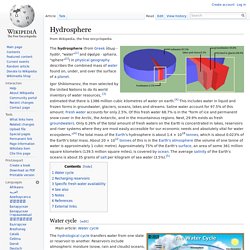
Igor Shiklomanov, the man selected by the United Nations to do its world inventory of water resources, [3] estimated that there is 1386 million cubic kilometres of water on earth.[4] This includes water in liquid and frozen forms in groundwater, glaciers, oceans, lakes and streams. Saline water account for 97.5% of this amount. Fresh water accounts for only 2.5%. Of this fresh water 68.7% is in the "form of ice and permanent snow cover in the Arctic, the Antarctic, and in the mountainous regions. Next, 29.9% exists as fresh groundwaters. Water cycle[edit] Main article: Water cycle An award-winning book titled Water by Marq de Villiers described the hydrosphere as a closed system in which water exists.
Asthenosphere. Characteristics[edit] Historical[edit] Although its presence was suspected as early as 1926, the worldwide occurrence of the asthenosphere was confirmed by analyses of earthquake waves from the 9.5 MW Great Chilean Earthquake of May 22, 1960.

References[edit] Jump up ^ Barrel, J. Lithosphere. Geology. Biosphere. The biosphere is the global sum of all ecosystems.
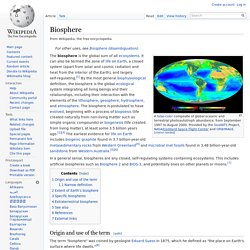
It can also be termed the zone of life on Earth, a closed system (apart from solar and cosmic radiation and heat from the interior of the Earth), and largely self-regulating.[1] By the most general biophysiological definition, the biosphere is the global ecological system integrating all living beings and their relationships, including their interaction with the elements of the lithosphere, geosphere, hydrosphere, and atmosphere.
The biosphere is postulated to have evolved, beginning with a process of biopoesis (life created naturally from non-living matter such as simple organic compounds) or biogenesis (life created from living matter), at least some 3.5 billion years ago.[2][3] The earliest evidence for life on Earth includes biogenic graphite found in 3.7 billion-year-old metasedimentary rocks from Western Greenland[4] and microbial mat fossils found in 3.48 billion-year-old sandstone from Western Australia.[5][6]
Natural Phenomena.